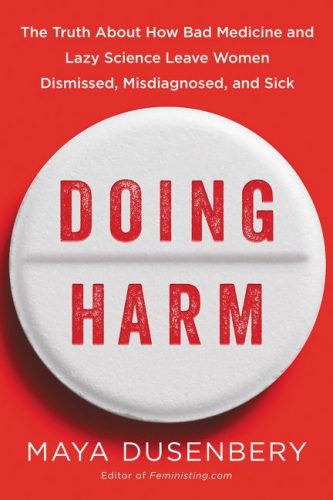Maya Dusenbery’s new book, Doing Harm, provides a poignant and critical examination of the implicit biases and sexism that cause the mistreatment of women in the contemporary medical system. Weaving together vivid anecdotes, rich history, and hard statistics on the medical treatment of women, Dusenbery fundamentally changes the way that we view the medical system—and how to fix it.
Following her personal story of surviving a rare disease, Dusenbery discusses how certain diseases—such as Alzheimer’s, chronic pain, an autoimmune disease—disproportionately affect women. The discrepancy is rooted in two intertwining issues: the “knowledge gap” and the “trust gap.” The knowledge gap means that the average doctor simply does not understand the important and nuanced differences between female and male biology. The “trust gap” refers to the fact that women’s claims of symptoms are often ignored and dismissed as hysteria. This two-pronged approach creates a self-reinforcing cycle: Are women’s claims being dismissed because of a lack of research on females? Or are they disregarded because of the stereotype that women are not accurate reporters of their symptoms?
Dusenbery walks readers through the history that has led us to this point. Since the 1950s, medical experiments excluded women, effectively preventing researchers from discovering how certain medications might impact females differently than they impact males. Fortunately, in 1993, Congress passed a law stating that all NIH-funded research must include women. However, despite this, studies still do not analyze research based on gender. As a result, we are left with an “add women and stir” approach, where doctors are unable to discern the differences of symptoms of diseases and reactions to treatments between men and women. This uncertainty can come at the cost of human life. Currently, doctors are more prone to misdiagnosing women and prescribing them overly high dosages for drugs.
While we may be conscious of the consequences that result from gender inequality, it may be difficult to conceptualize its concrete harms. I think that Dusenbery’s story—and the stories of countless women who were harmed by the pitfalls the medical system—serves as a major wake-up call by explicitly describing the tangible suffering resulting from sexism. By packing every page gripping detail, Dusenbery’s book struck a chord with me. It is terrifying to realize that we cannot trust the system that is supposed to protect us, that sexism can manifest in subtle forms, and that these small subtleties—resulting from doctors’ unconscious biases, faulty research, and a sexist history beyond our control—can lead to big harms. And it is much more difficult to call out these small discriminatory acts than overt expressions of gender discrimination.
Dusenbery, however, closes the book with hope. Despite tangible harms that results from our current healthcare system, the fix is glaringly simple: doctors must openly listen to female patients and to regard them as a source of knowledge. Doing Harm encourages us to unabashedly confront the shortcomings of our medical system in order to create a more equitable and healthier world for everyone.

